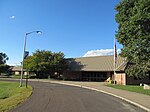North Hatfield Historic District
Hatfield, MassachusettsHistoric districts in Hampshire County, MassachusettsHistoric districts on the National Register of Historic Places in MassachusettsNRHP infobox with nocatNational Register of Historic Places in Hampshire County, Massachusetts ... and 1 more
Use mdy dates from August 2023

The North Hatfield Historic District encompasses a small rural village in Hatfield, Massachusetts. It consists of a small cluster of buildings along West Street (United States Route 5) and Depot Road in the vicinity of a former railroad station. It includes a few buildings associated with the railroad, including a depot and freight buildings, as well as commercial and residential structures, most of which postdate the 1848 arrival of the railroad. The village was important in the community as an arrival point for immigrants working in its fields and industry. The district was listed on the National Register of Historic Places in 1997.
Excerpt from the Wikipedia article North Hatfield Historic District (License: CC BY-SA 3.0, Authors, Images).North Hatfield Historic District
West Street,
Geographical coordinates (GPS) Address Nearby Places Show on map
Geographical coordinates (GPS)
| Latitude | Longitude |
|---|---|
| N 42.409166666667 ° | E -72.623888888889 ° |
Address
Cemetery
West Street
01066
Massachusetts, United States
Open on Google Maps









